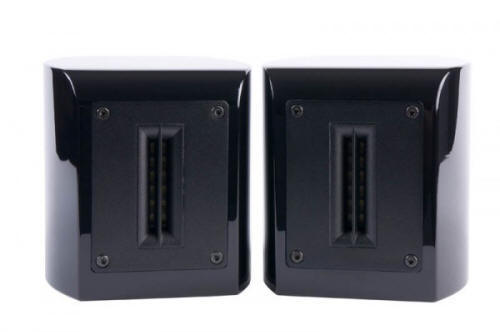
You are reading the older HTML site
Positive Feedback
ISSUE
27
av123
Onix ERT Supertweeters
as reviewed by Clay Swartz

 |
|
|
You are reading the older HTML site
Positive Feedback
ISSUE
27
av123 Onix ERT Supertweeters as reviewed by Clay Swartz
|
|
|
The better an audio system can reproduce the harmonic structure of a note, the more real it sounds. Most speaker specifications misrepresent the sound that the speaker can produce in a real room. The measurements are usually made one meter in front of the speaker. At an average listening distance of 9 to 14 feet, lows and middle frequencies are not much affected, but high frequencies are attenuated. In the last few years, new tweeters with better frequency extension have been developed, with materials like diamond, beryllium, ceramic, and so on. These tweeters are very expensive, and are usually found only on very pricey speakers. A diamond tweeter costs about $2500, just for the driver! A solution for the less well heeled is the use of supertweeters. I got interested in supertweeters after reading some very positive reviews. These tweeters sell for between $1250 and $3000. The manufacturers include Tonian ($1250), Townshend Audio ($1500), muRata ($1825-2950), and Tannoy ($2200). I could not justify this kind of expenditure, so I looked on the internet for more reasonably priced models. I found the Onix ERT tweeters ($345/pair) on the AV123 site (www.av123.com). A friend of mine bought a pair, and I was so impressed with them that I tried to get a pair for review. They were constantly sold out, so I ordered my own pair. A supertweeter only functions at frequencies above 10,000 cycles. Most speakers are rated up to 20,000 cycles, but people with good hearing can only hear up to around 16,000, and the greater the age of the listener, the lower the top frequency they can perceive. These high frequencies are usually second or higher harmonics of a primary frequency, and they are usually lower in volume. High frequencies do not usually have much amplitude. Even traveling through air reduces their power, and they are easily absorbed. They are also very directional. A question that must be asked is: Why is this kind of frequency extension needed when most people do not hear above 16,000Hz? The first part of the answer is that a supertweeter still produces sound down into the audible range. With the ERT set at the 11,000Hz crossover point, it still has output down to below 9000Hz. The second part is that a listener can sense sound above what he or she can perceive as a sound. Speakers with extended-range tweeters, like the Avalon Diamonds and the JM Labs Beryllium models, always sound better to me than speakers with normal tweeters. Most people think that more high frequencies will make music sound edgier, but what makes treble sound edgy is not too high a frequency response, but high frequencies that are chopped off too low. The upper harmonics add a sweetness that is not there if they are chopped off. The upper harmonics also add a sense of space to the soundfield.
Ribbon tweeters like the ERT have been around for years. Ribbons usually have a limited ability to move air, so they are best used at higher frequencies, where the amount of air that must be moved is small. AV123 uses the ERT supertweeter, in addition to a regular tweeter, in the more expensive models of their Reference line of speakers. The ERT is rated to 45,000Hz. The JM Labs Beryllium supertweeter is rated to 40,000Hz. The Tannoy supertweeters (there are three models) are rated to 54,000Hz. The Avalon Diamond supertweeter, the Townshend, and the muRata are rated to 100,000Hz. The ERT tweeters are direct-marketed by AV123. If they were sold through retail outlets, they would probably cost $550 to $600. The tweeters arrived five days after I placed my order, and the shipping cost less than $20. The enclosures were nicely finished in black. Each has a flat front and back, while the sides flair slightly out from the front, then curve in toward the back. Each tweeter is provided with a decent speaker cable that plugs into the main speaker's binding posts, in piggyback fashion. You plug your positive speaker lead into one of two connections on the back of the tweeter. The top one uses the 15,000Hz crossover point, while the lower one crosses over at 11,000Hz. The negative lead plugs into a connector at the bottom of the tweeter. There is a knob between the positive and negative terminals that selects one of four efficiency settings, in order to match the efficiency of the main speakers. If the top of your speaker is flat, the ERT should be set directly above the tweeter. If you do have box speakers, or have speakers with rounded tops, you may need to fashion supports or stands for the tweeters.
I tried the ERTs with three very different speaker systems. The first, which belongs to a friend of mine, is inexpensive but a sonic overachiever—two small Cambridge Audio monitors with two Thorough Bass subwoofers. The subs give the system very good bass. The midrange is smooth. The system images well but lacks macro- and micro-dynamics. The highs are the system's biggest problem. There is probably little response over 10,000Hz, and the system lacks detail and sparkle. The addition of the ERTs totally transformed the sound. The highs were now sparkling, and there was a lot more detail. There was also an increased sense of dynamics. Instruments and voices had a lot more character. We could hear vocal characteristics and micro-dynamics that made the sound more realistic, with much more of a feeling that music was being played in a real room. With near-state-of-the-art treble and bass, my friend's cheap speaker system was producing sound as good as that of many audiophile systems. He feels that the ERT tweeters are the best and most cost-effective improvement that he has ever made to his system. The second speaker system was a pair of four-way NHT Reference Four speakers that I had for review on www.audaud.com. The NHTs are pretty good speakers that sell for $1800 a pair. The NHTs were a much bigger challenge for the ERT tweeters, because their aluminum dome tweeters already produced pretty good highs. Because the tops of the NHTs are not flat, I constructed temporary platforms to allow the tweeters to sit above the NHT tweeters. Hooking up the ERTs produced instant improvements. The highs became airier, yet more delicate. There was a greater sense of speed and life. Room acoustics were enhanced. Instruments had more character and nuance. The transformation was not total, as it was with the Cambridge speakers, but the improvements were very worthwhile, and they made the music more realistic and more interesting. The third set of speakers were my Eminent Technology LFT-8s with Thorough Bass subwoofers. The LFT-8s are two-way ribbon speakers with dynamic woofers. The highs are already fast and detailed, so these speakers were an even bigger test for the ERTs. They were up the challenge. The soundstage became much larger, with more solidity and detail. Highs shimmered, and became even airier, yet more solid. High-frequency transients were much more evident. The music had more emotional involvement. Everything I played sounded good. Again, the tweeters did not transform the system, but added worthwhile improvements that I would not want to live without. The AV123 Onix ERT supertweeters improved the sound of every speaker system I tried them with. They add greatly to the excitement and enjoyment of listening to music, and even better, most people can afford them. They are not going to leave my system any time soon. I do not know if the more expensive supertweeters sound better, although I would be glad to make the comparison. I plan to try another ERT on my center-channel speaker. This could produce some very interesting results. I congratulate AV123 for creating an effective and cost-effective product that has the potential to improve many systems. The bad news is that they are again sold out, and will not be available until early December 5, so if you want a pair, I suggest that you order them now. Clay Swartz Specifications
ERT Supertweeters
AV123
|